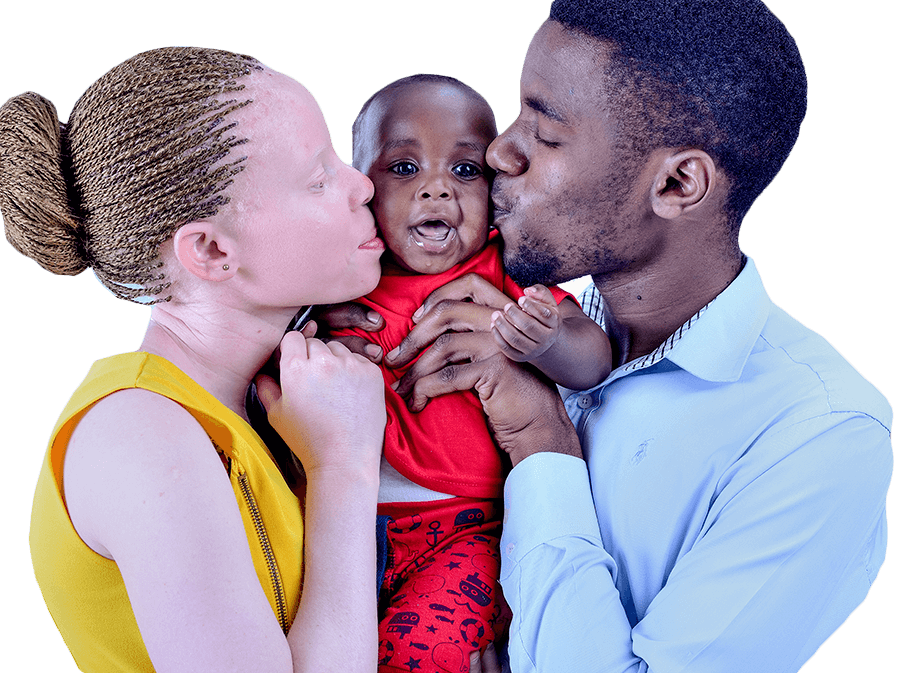Albinism is a rare group of genetic disorders that causes the skin, hair, or eyes to have little or no colour. Albinism is also associated with vision problems. In so many African countries, people with albinism are misunderstood and mistreated because of their skin colour.
Read More
It's time for us to stand together as a community and say no to stigmatisation and discrimination of people with albinism.
- A defect in one of several genes that produce or distribute melanin.
- The defect may result in the absence of melanin production, or a reduced amount of melanin production.
- The defective gene passes down from both parents to the child.
Because beauty lies within, I am more than the colour of my skin.
Find Out More contact usWe are all equal. See beyond my skin and say no to stigmatisation.
The way you’re loved and cherished is the same way
I want to be loved and cherished. When you see beyond my skin, you see a better
tomorrow for us all.
Myth
They are results of inbreeding or incest, that is, breed from closely related people, especially over many generations.
Fact
Albinism is an inherited disorder. It is inherited as a recessive gene from both parents. As with all recessive conditions, the chances of two people carrying the same recessive gene increase if the two have recent common ancestors. Therefore, while albinism is not necessarily a result of incest, marriage between close relatives can increase the chances of a child being born with albinism. Therefore having children with a relative is highly discouraged. The body of people living with Albinism has little or no ability to produce the colour of the skin, hair and eyes. This colour is called “melanin”.
Myth
People with albinism are sterile.
Fact
This is not true. Persons with albinism are fertile and can have children.
Myth
People with albinism cannot see during the day but see well at night.
Fact
People with albinism have eyesight problems due to lack of ‘melanin’ pigmentation in the retina. They can see during the day and also at night, but they may either be short or long sighted and may need sight aids.
Myth
Albinism is contagious.
Fact
Albinism is a genetic condition passed on by both parents. Each parent must be a carrier, and both must pass on an albinism gene for someone to be born with the condition. It cannot be caught and is not contagious.
People with albinism tend to have more developmental difficulties. True, but only because of the vision problems and social pressures. When you can't read the blackboard or you're ostracized from society and can't go to a normal school, you often fall behind academically.This will affect their grades thereby reducing their chances of being employed and opportunities for societal integration.
Myth
Albinism is a punishment or a curse from the gods or ancestral spirits due to wrongs done in the family.
Fact:
Albinism is a genetic condition that is passed on from parents to children. Many people are carriers of this recessive gene. Albinism is not a curse.
Myth
A person with albinism cannot have regularly pigmented children.
Fact
A person with albinism can give birth to regularly pigmented children if his/her partner is not a carrier of a similar recessive gene for albinism. The children may be carriers of the recessive gene but it will not be expressed in them.
Myth
People with albinism are not intelligent.
Fact
This is not true. Persons with albinism are intelligent and also perform well academically like other normally pigmented people. There are teachers, lawyers, politicians and musicians who are living with albinism.
Myth
The mother slept with a white man.
Fact
Children born with albinism may look ‘white’ due to absent or reduced pigmentation but are not products of cross race sexual relationships.
Myth
People with albinism cannot go outside during the day.
Fact
People with albinism can go outside at any time but need to take extra precautions when out in the sun. Protective clothing, sunscreen and a hat are required all year round to minimize the risk of skin damage from the sun.
TRUTH: You cannot catch albinism because it is a genetic condition passed from BOTH parents to children.
TRUTH: Contact with persons with albinism will never bring bad luck, sickness or death, but it fosters respect with other humans, kindness and human dignity.
TRUTH: No one has or can become lucky or rich or healed from the use of albino body parts.

TRUTH: People with albinism are NOT curses or ghosts and certainly do not disappear when they die. In fact, they are human beings with simple inherited genetic conditions. Both parents should have the albino gene to pass it on to their child even if they themselves do not have albinism.
TRUTH: No, academic shortcomings are vision related. They need special aids for they have eyesight challenges e.g. bigger prints and spectacles. Failure to fit in and bullying at school also leads to stress, low self esteem and isolation thus compounding their learning challenges.